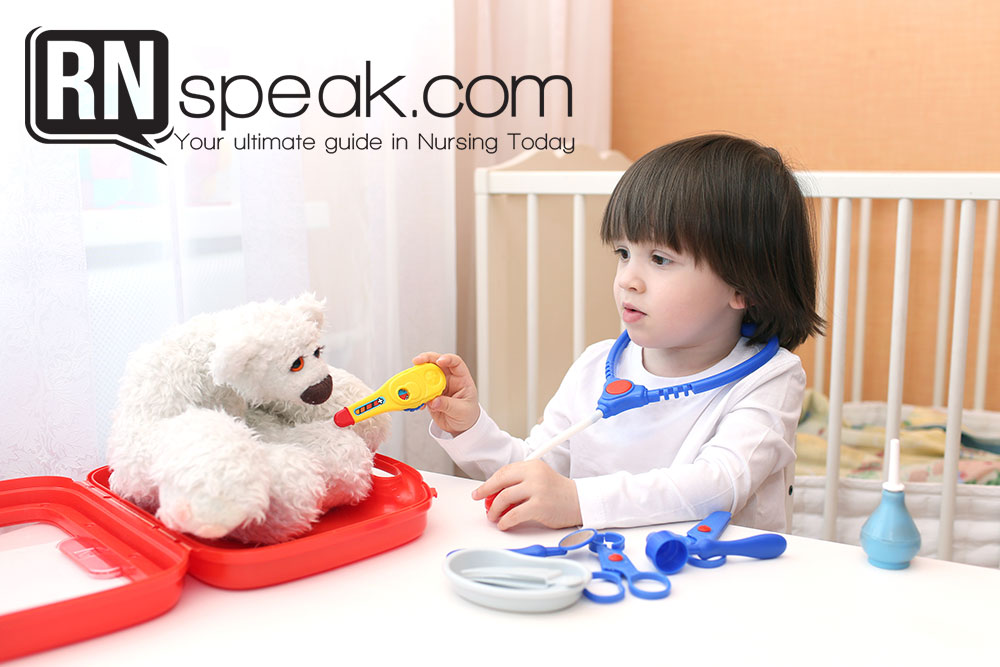Pretend play is very common among kids, and this is one of the best ways to enlighten children about different roles in the society. One of the common pretend plays is Pretend Play – Doctor/Nurse. Pretty sure that at least 1 in every 3 kids had imagined themselves either as a doctor or a nurse. Parents can actually benefit from their kid’s vivid imagination, and use this pretend plays to teach them the fundamentals in nursing.
“What can you possibly teach to a 5-year-old kid?”
Good question!
Of course, before telling you how doable it is, I have already tried it on my own. I have a 5-year-old daughter, and she has a good amount of knowledge about the proper handwashing, wound cleaning, auscultating heartbeat, palpating the pulse, taking the temperature, and doing tepid sponge bath. Here are simple ways on how you can teach them.
Proper Handwashing
Keeping your child’s hands clean is very important, simply because it’s a common portal of entry for microorganisms. Well, I bet you’ll tell me that the “Happy Birthday” song does the trick. Sorry, you’re wrong. Actually, this is the reason why we are wrong, because we are basing it on the quantity and not on the quality. Remember, the medical and surgical handwashing requires not only the length of time but also the technique of washing our hands.
What will they learn? They will learn about the proper manner of washing their hands such as the following:
- Rub palm to palm
- Rub palm to the back of the hands (vice versa)
- Rub palm to palm with fingers interlaced
- Rotationally rubbing each finger with the opposite hand (vice versa)
- Rubbing up to the wrist area of each hand
- The direction of how to rinse hands with water: Hands should be pointing in a downward direction and water should flow from the wrist down to the fingertips. Alternately wash each hand.
- Shake excess water, and dry hands using a dry clean towel.
Wound Cleaning
Wound cleaning is not that complicated, you just need to show them the circular motion of cleaning the wound (wiping from the center outward in circulation motion, just like making a swirl). To make this more interesting, you make use of catsup or food coloring so that the wound would look more realistic.
What they will learn? They will learn how to prevent further spread of microorganisms since the manner of cleaning is not towards the cut or abrasion, which also implies that we are not adding more germs to the wound.
Auscultating for the Heartbeat
It would be fun if your kids wear a scrub suit or white coat, it will make them feel the role they are portraying. Auscultation is one of the very common things that kids do in they pretend to play. So why not really teach our kids how to properly auscultate.
What will they learn? In this activity, kids can better appreciate and understand the function heart, because they can actually hear how it pumps as it distributes the oxygenated blood to our systems. Since they are still young, there isn’t any malice if you teach them where exactly heartbeat can be best heard (apex of the heart or just under your left nipple).
Palpating Pulse
Checking how to feel the pulse is perfect, after teaching proper auscultation because it’s relevant to the function of the heart (facilitating blood circulation).
What will they learn? They can learn about a normal and strong and fast pulse. For them to see the difference, let them feel their pulse while at rest. It is important to remind them that they must be steady and still for them to feel the pulsation. Then after palpating their pulse, let them do 10 jumping jacks, or merely run around the house for a few seconds then let them feel their pulse again. This time, they must feel that the pulsation is faster and stronger as compared to their rest state.
Taking Temperature
Since thermometers today are digital, it is much easier to teach our children how to determine the temperature of the person. Aside from this, there is a beep sound which indicates when the result is ready. The only possible problem when teaching this task is, if they know how to read numbers.
What will they learn? They will be able to identify whenever a person has a fever. A person is considered to be having a fever if their temperature is 37.8°C or 100°F. So in case, they are not feeling well, they can simply get a digital thermometer and place it in their mouth. Take note, you must also underscore how far they can only place the thermometer in their mouth.
Tepid Sponge Bath
Speaking of fever, one of the immediate interventions we usually do, whenever someone is feverish, is providing Tepid Sponge Bath or TSB. It’s a very easy task that a kid, as young as 3 years old, can do. You can use your kid’s doll to demonstrate how to properly provide TSB
What will they learn? This task is really not complicated, and what’s nice about it, is that they can also use this technique when taking a bath. The manner of wiping ourselves during TSB is also the same way when we’re cleaning our body during shower. Thus, you’re training them how to properly bathe themselves as well.
Teaching our child as early as now is a good way of preparing her in becoming more efficient. These tasks are not limited among health care providers because these are basic skills that are useful in our everyday lives. Let us make kid’s games more functional because not only it’s enjoyable, but it is also a fun and interesting way of teaching them to become more independent.








